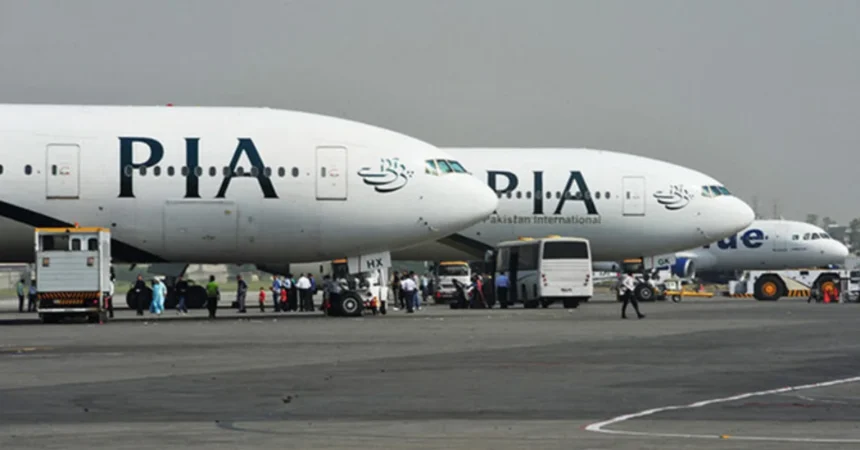Introduction
Pakistan International Airlines (PIA), the national carrier, recently faced a significant operational setback as it announced the cancellation of six international and domestic flights. The cancellations have raised concerns about the ongoing financial difficulties and operational challenges the airline is grappling with. PIA has long been a critical part of Pakistan’s transportation infrastructure, connecting the country to the world and facilitating domestic travel. However, in recent years, the airline has faced numerous crises, from financial losses to mismanagement and regulatory issues.
This article delves into the reasons behind these flight cancellations, the impact on passengers, and the broader implications for the struggling airline. It will also examine the potential solutions and reforms that could help PIA regain its former stature.
The Flights That Were Cancelled
According to reports, six flights—both international and domestic—were abruptly cancelled. The affected flights were scheduled to operate between key destinations, impacting hundreds of passengers. Among the international routes affected were those connecting Pakistan with Europe and the Middle East, while several domestic flights between major cities like Karachi, Islamabad, and Lahore were also grounded.
The sudden cancellations left many passengers stranded, forcing them to make alternative travel arrangements. While PIA has apologized for the inconvenience caused to its customers, the cancellations have once again drawn attention to the airline’s deep-rooted issues.
Operational Challenges: A Persistent Issue for PIA
Flight cancellations are not a new phenomenon for PIA. The airline has been struggling with a variety of operational challenges for years, which have been exacerbated by financial mismanagement and inefficiencies. Here are some key factors contributing to PIA’s ongoing operational woes:
- Financial Losses:
PIA has been operating at a loss for several years. The airline’s financial problems stem from various factors, including poor management decisions, overstaffing, and rising operational costs. The airline has consistently failed to break even, leading to mounting debt and an inability to invest in modernizing its fleet or improving services. These financial challenges have had a direct impact on its ability to maintain a consistent and reliable schedule. - Aging Fleet:
One of the significant challenges facing PIA is its aging fleet. Many of its aircraft are older models that are expensive to maintain and prone to technical issues. Frequent maintenance delays and breakdowns have led to flight cancellations and delays. The airline has been unable to invest in newer, more fuel-efficient aircraft due to its financial struggles, further compounding the problem. - Staff Shortages and Strikes:
Another operational challenge for PIA is its workforce. Over the years, the airline has faced internal labor disputes, strikes, and protests by employees. These disruptions have often resulted in operational setbacks, including flight cancellations. In some cases, pilots and ground staff have refused to work due to disputes over wages, benefits, and working conditions. - Fuel Shortages:
Fuel shortages have also played a role in the airline’s recent cancellations. Rising global fuel prices, combined with PIA’s financial constraints, have left the airline struggling to meet its fuel demands. As a result, the airline has been forced to cancel flights when fuel supplies are insufficient, leaving passengers frustrated.
Impact on Passengers
The cancellation of six flights has had a significant impact on passengers, both international and domestic. Travelers who had planned trips for business, tourism, or personal reasons found themselves stranded or forced to make expensive last-minute alternative arrangements. The sudden nature of the cancellations also meant that many passengers were not informed in advance, leading to confusion and chaos at airports.
Passengers have voiced their frustrations on social media, criticizing PIA for its lack of communication and customer service. Many have called for the airline to provide better compensation for those affected by the cancellations, including refunds, rebooking options, and accommodations for stranded travelers.
Financial Implications for PIA
The cancellation of flights also has financial implications for PIA. Every cancelled flight results in lost revenue, both from ticket sales and additional services such as baggage fees and in-flight purchases. Furthermore, the airline is likely to face compensation claims from passengers seeking refunds and other forms of reimbursement.
These losses only add to PIA’s existing financial burdens, further deepening the airline’s crisis. With the airline already struggling to stay afloat, the recent cancellations are yet another reminder of the urgent need for reform and restructuring.
The Broader Crisis Facing PIA
The recent flight cancellations are just one symptom of a much larger crisis facing PIA. The airline’s problems extend far beyond operational issues and flight disruptions. PIA’s financial instability, mismanagement, and inability to adapt to the changing dynamics of the global aviation industry have left it in a precarious position.
In recent years, the airline has been forced to cut routes, reduce staff, and delay salary payments to employees. Additionally, PIA has been subject to international scrutiny following incidents involving its pilots. In 2020, the European Union Aviation Safety Agency (EASA) suspended PIA’s authorization to fly to EU destinations after it was revealed that nearly 40% of the airline’s pilots had fraudulent licenses. This incident severely damaged PIA’s reputation and resulted in a significant loss of business.
Government Intervention and Restructuring Efforts
The Pakistani government has intervened multiple times in an attempt to save PIA. These efforts have included financial bailouts, management changes, and plans for privatization. However, none of these measures have been successful in bringing about the necessary changes to turn the airline around.
The government has also explored the possibility of restructuring PIA’s debt and working with international consultants to identify areas for improvement. Some have called for the airline to be partially or fully privatized, arguing that the private sector may be better equipped to manage the airline’s operations and finances. However, such efforts have faced resistance from labor unions and political opposition.
In 2021, the government unveiled a five-year restructuring plan aimed at reducing PIA’s losses, modernizing its fleet, and improving operational efficiency. The plan also includes efforts to streamline the airline’s workforce and cut costs. While this plan represents a step in the right direction, its success remains uncertain given the airline’s entrenched problems.
Potential Solutions for PIA’s Recovery
To prevent further cancellations and ensure the long-term viability of the airline, PIA needs to take several critical steps:
- Fleet Modernization:
PIA must prioritize the modernization of its fleet. Investing in new, fuel-efficient aircraft would reduce maintenance costs, improve reliability, and enhance the overall passenger experience. The airline could explore leasing options or partnerships with other carriers to acquire newer aircraft. - Financial Restructuring:
PIA must address its financial issues by restructuring its debt and cutting unnecessary costs. This includes reducing overstaffing and improving operational efficiency. The airline should also explore revenue-generating opportunities, such as expanding its cargo services or entering into codeshare agreements with other international airlines. - Improved Customer Service:
PIA’s reputation has been severely damaged by its lack of communication and customer service during disruptions. The airline must invest in improving its customer service infrastructure, including better communication with passengers during flight cancellations and delays. Offering more flexible rebooking and refund options would also help restore customer trust. - Strengthening Operational Efficiency:
Improving operational efficiency should be a top priority for PIA. This includes better management of flight schedules, crew assignments, and fuel procurement. The airline must also invest in staff training and development to ensure that its workforce is capable of meeting the demands of modern aviation. - Public-Private Partnerships:
To overcome its financial and operational challenges, PIA could explore public-private partnerships (PPP). Such collaborations could provide the airline with the resources and expertise needed to improve its operations without the risks associated with full privatization. For instance, PIA could partner with a private airline to manage specific routes or services.
The cancellation of six PIA flights, both international and domestic, is a stark reminder of the challenges facing Pakistan’s national airline. Operational inefficiencies, financial struggles, and an aging fleet have combined to create a crisis that requires urgent attention. Passengers have been left frustrated, and PIA’s reputation has taken yet another hit.
To prevent further disruptions and restore confidence in the airline, PIA must embark on a comprehensive reform process. This includes modernizing its fleet, improving customer service, and restructuring its finances. With the right strategy and government support, PIA can overcome these challenges and once again become a reliable and respected airline on both domestic and international routes.
#PIAFlightCancellations #PakistanInternationalAirlines #PIAOperationalChallenges #AviationCrisis #FlightDisruptions #PakistanAviation #PIAStruggles #AirlineReform #CustomerImpact #FlightCancellations







